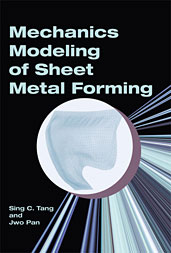Journal Article
Analytical Stress Intensity Factor Solutions for Spot Welds Joining Sheets of Different Materials and Thicknesses
2010-04-12
2010-01-0962
In this paper, analytical stress intensity factor solutions for spot welds with ideal geometry in lap-shear specimens of different materials and thicknesses are presented as functions of the applied load, the elastic material property parameters, and the geometric parameters of the weld and specimen. The analytical stress intensity factor solutions are selectively validated by the results of a three-dimensional finite element analysis for a dissimilar spot weld with ideal geometry in a lap-shear specimen. Finally, selected stress intensity factor solutions at the critical locations of spot welds in lap-shear specimens of dissimilar magnesium, aluminum and steel sheets with equal and different thicknesses are presented in the normalized forms as functions of the ratio of the specimen width to weld diameter.

